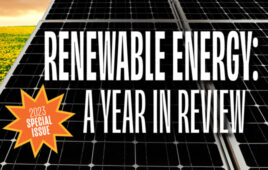THE SOLAR INDUSTRY IS RESILIENT
THE LAST YEAR IN SOLAR HAD ALL THE INGREDIENTS FOR FAILURE. The uncertainty around tariffs on imported solar panels brought 2018 planned projects to a standstill. The industry pr edicted a deflated utility-scale market and installation job losses. To be sure, once the tariffs were announced in January, the market was hurt, but the damage was considerably less severe than expected. Installations did dip from 2017, but only in singledigit percentages. Module prices eventually evened out, and the utility-scale market is back on the rise.
A U.S. Solar Market Insight Report from Wood Mackenzie Power & Renewables and SEIA found that utility-scale solar project procurement soared in Q2 2018 as component prices continued to decline. More large solar projects being announced is a sign the industry is back on the right path, the groups said.
“Once lower-than-expected module tariffs were announced in January 2018, developers and utilities began announcing new projects,” wrote Colin Smith, Wood Mackenzie senior analyst, in the report. “As we move toward 2019, we expect to see continued procurement growth as developers look to secure projects they can bring online before the investment tax credit (ITC) steps down to 10% in 2022.”
Solar’s dominance is now being felt across all corners of the country. Most of the utility-scale projects announced this year will come online in 2020. By then, 28 states are expected to add at least 100 MW of solar annually, and 25 states will have more than 1 GW of solar PV—compared to only two states with 1 GW in 2010. A utility-scale report from the Lawrence Berkeley National Laboratory found that twothirds of all states are currently home to one or more utilityscale solar projects, and the utility-scale market will continue to lead U.S. solar growth for at least another six years.
Large U.S. corporations, like Walmart and IKEA, were on track to procure over 4 GW of utility-scale wind and solar capacity in 2018—breaking 2015’s all-time high by over 750 MW. With more mega organizations getting on board with solar power, average citizens can see the difference renewables can make. A Global Strategy Group poll found that 76% of U.S. voters think their utility should deploy more solar. Nine out of 10 respondents also said their power company should not be able to stop them from using solar energy. The support behind solar in the United States is the strongest it’s ever been.
Regardless of the obstacles the solar industry may face in the coming years, one thing for sure is that it will survive. A recent DNV GL report expects solar PV to deliver 40% of global electricity generation by 2050. The only way to get there is one project at a time.
KELLY PICKEREL
Editor In Chief
Solar Power World
@SolarKellyP





I Love The Info.You at Solar World Provide. Thamks Ken